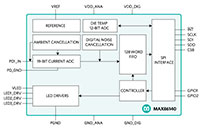Maxim's MAX86140 and MAX86141 are ultra-low-power, completely integrated, optical data acquisition systems. On the transmitter side, the IC has three programmable high-current LED drivers that can be configured to drive up to six LEDs. With two devices working in master-slave mode, the LED drivers can drive up to twelve LEDs. On the receiver side, the MAX86140 has a single optical readout channel and the MAX86141 has two that can operate simultaneously. Both ICs have a low-noise signal conditioning analog front-end (AFE) which includes a 19-bit ADC, an industry-lead ambient light cancellation (ALC) circuit, and a picket fence detect-and-replace algorithm. The devices offer low power consumption, compact size, an industry-lead ambient light rejection and are easy/flexible-to-use.
The MAX86140 and MAX86141 operate on a 1.8 V main supply voltage and a 3.1 V to 5.5 V LED driver supply voltage. Both devices support standard SPI compatible interface and fully autonomous operation. The devices offer a large 128-word built-in FIFO and are available in a compact wafer-level package (20-WLP).
Design Solutions - Train Your Fitness Monitor to Deal with Any Lighting Conditions
News Release - Enabling a Healthier World with Wearables for Preventive Health and Fitness Applications
| Features |
|
|
- Complete single-channel, optical data acquisition system
- Built-in algorithm further enhances rejection of fast ambient transients
- Optimized architecture for transmissive and reflective heart rate or SpO2 monitoring
- Low dark current noise of <50 pA RMS (sample-to-sample variance)
- Lower effective dark current noise achievable through multiple sample modes and on-chip averaging
- High-resolution, 19-bit charge integrating ADC
- Three low-noise, 8-bit LED current DACs
- Excellent dynamic range >90 dB in white card loop-back test (sample-to-sample variance)
- Dynamic range extendable to >104 dB for SpO2 and >110 dB for HRM with multiple sample modes and on-chip averaging
|
|
- Excellent ambient range and rejection capability
- >100 μA ambient photodetector current
- >70 dB ambient rejection at 120 Hz
- Ultra-low-power operation for body wearable devices
- Low-power operation, optical readout channel <10 μA (typ) at 25 sps
- Short exposure integration period of 14.8 μs, 29.4 μs, 58.7 μs, 117.3 μs
- Low shutdown current = 20 μW (typ)
- Built-in algorithm further enhances rejection of fast ambient transients
- Miniature 2.048 mm x 1.848 mm, 5 x 4 0.4 mm ball pitch WLP
- -40°C to +85°C operating temperature range
|
| Applications |
|
|
- Optimized performance to detect
- Muscle oxygen saturation (SmO2 and StO2)
- Optical heart rate
- Oxygen saturation (SpO2)
|
|
- Optimized for wrist, finger, ear, and other locations
- Wearable devices for fitness, wellness, and medical applications
|
